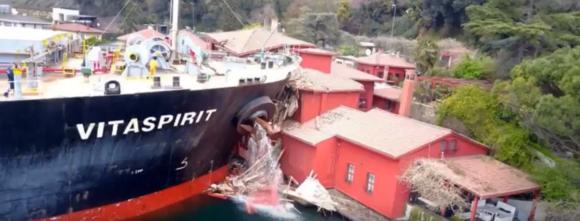 Saturday was a bad day on the Bosphorus. The Maltese-flagged 74,269 DWT bulk carrierVitaspirit suffered a steering gear failure while transiting Istanbul’s Bosphorus Strait. The ship was traveling south, approaching the Second Bosphorus Bridge, when it veered out of control. Fortunately, it missed the bridge, but the Hekimbasi Salih Efendi Mansion on the shore near the bridge was not as lucky. The 19th-century mansion was seriously damaged. The mansion’s roof and upper floors collapsed and videos showed the basement slumping into the water. The mansion was used to host weddings and concerts. No one was reported to be injured in the collision.
Saturday was a bad day on the Bosphorus. The Maltese-flagged 74,269 DWT bulk carrierVitaspirit suffered a steering gear failure while transiting Istanbul’s Bosphorus Strait. The ship was traveling south, approaching the Second Bosphorus Bridge, when it veered out of control. Fortunately, it missed the bridge, but the Hekimbasi Salih Efendi Mansion on the shore near the bridge was not as lucky. The 19th-century mansion was seriously damaged. The mansion’s roof and upper floors collapsed and videos showed the basement slumping into the water. The mansion was used to host weddings and concerts. No one was reported to be injured in the collision.
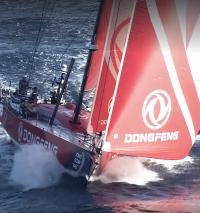 Yesterday, we posted about the upcoming Golden Globe 2018 Race in which traditional sailboats will race around the globe using only the technology available in the original race in 1968. The idea has a certain appeal but also definite limitations. There is something to be said for technology that lets arm-chair sailors catch a glimpse of the power and majesty of racing yachts screaming along in mid-ocean.
Yesterday, we posted about the upcoming Golden Globe 2018 Race in which traditional sailboats will race around the globe using only the technology available in the original race in 1968. The idea has a certain appeal but also definite limitations. There is something to be said for technology that lets arm-chair sailors catch a glimpse of the power and majesty of racing yachts screaming along in mid-ocean.
One of the most thrilling technologies, at least to my eyes, are the myriad of video feeds being recorded on the boats competing in the Velux and Volvo round the world races, among others. And of the range of cameras, some of the most exciting footage has come from drones launched and controlled from the decks of the racers.
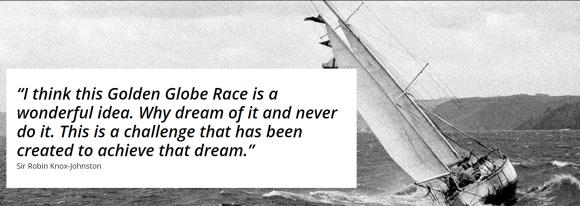 Fifty years ago this year, nine sailors set off in the Sunday Times Golden Globe Race. Only one, Robin Knox-Johnston sailing his 32-foot Bermudan ketch Suhaili, finished the race, becoming the first person ever to sail single-handed non-stop around the globe. This June, the race is being recreated in the Golden Globe 2018.
Fifty years ago this year, nine sailors set off in the Sunday Times Golden Globe Race. Only one, Robin Knox-Johnston sailing his 32-foot Bermudan ketch Suhaili, finished the race, becoming the first person ever to sail single-handed non-stop around the globe. This June, the race is being recreated in the Golden Globe 2018.
Unlike other single-handed round-the-world races, such as the Vendee Globe, which is sailed in modern Open 60 sailboats, including many featuring foiled hulls, the boats and the technologies used in the upcoming Golden Globe 2018 will harken back to 1968. From the GGR website:
As a RETRO Race, for the Golden Globe, generally speaking only equipment that was available to Robin Knox Johnston on Suhaili in 1968 may be used. That means NO GPS, Chart plotters, electronic wind instruments, electric autopilots, electronic log, iPhone, satellite phones, digital cameras, computers, cd players, pocket calculators electronic clocks and watches, water makers, carbon fibre, Kevlar, spectra etc… so it is back to film cameras, cassette tapes, sextants, wind up clocks, trailing logs and Dacron sails, wind vanes and typewriters.
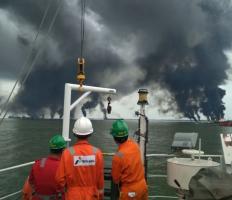
Photo: Pertamina
Six days ago, oil began spilling into Borneo’s Balikpapan Bay. The oil would spread to cover an area of nearly 13,000 hectares and pollute 60 km of coastal ecosystems, including mangrove wetlands and marine mammal habitats. At least one protected dugong was killed. The spill would also create an overpowering stench sweeping across Balikpapan, a city of 700,000 people. On March 31, the oil caught fire near the Panama-flagged bulk carrier, MV Ever Judger. At least four fisherman died and a fifth remains missing. One of the crew members on the bulker also suffered burns.
Where did the oil come from? For the first four or five days, there was only denial and finger-pointing.
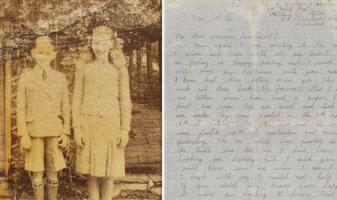 A new exhibit has recently opened at the Postal Museum in London — Voices from the Deep. The exhibit features undeliveredd letters retrieved from the wreck of the SS Gairsoppa, a British merchant ship which was sunk by a U-boat 300 miles southwest of Galway Bay in 1941. The SS Gairsoppa is best known for her cargo, which as well as pig iron and tea included 240 tonnes of silver. Between 2012-2014, Odyssey Marine Exploration, under contract with the UK government, recovered close to 99% of the insured silver from the wreck which is almost three miles deep.
A new exhibit has recently opened at the Postal Museum in London — Voices from the Deep. The exhibit features undeliveredd letters retrieved from the wreck of the SS Gairsoppa, a British merchant ship which was sunk by a U-boat 300 miles southwest of Galway Bay in 1941. The SS Gairsoppa is best known for her cargo, which as well as pig iron and tea included 240 tonnes of silver. Between 2012-2014, Odyssey Marine Exploration, under contract with the UK government, recovered close to 99% of the insured silver from the wreck which is almost three miles deep.
Remarkably, something far more rare than silver was also recovered from the wreckage. Twelve bundles of mail bundles of letters, over 700 letters and postcards, were miraculously preserved in an air pocket in the hold of the ship.
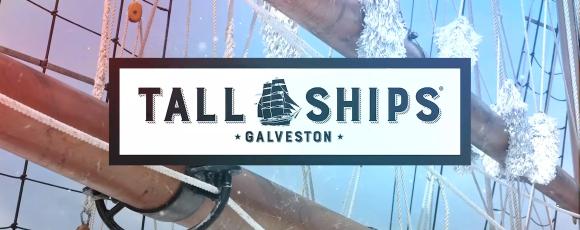 A fleet of tall ships is sailing to Galveston Island, Texas which will host Tall Ships Galveston from April 5 – 8th to kick off the Tall Ships Challenge Gulf Coast 2018 tall ship race. Included in the fleet will be:
A fleet of tall ships is sailing to Galveston Island, Texas which will host Tall Ships Galveston from April 5 – 8th to kick off the Tall Ships Challenge Gulf Coast 2018 tall ship race. Included in the fleet will be:
- Galveston’s Elissa, an 1877 square-rigged three-masted iron barque,
- Oliver Hazard Perry, a three-masted steel ship, commissioned in 2015, the largest civilian Sailing School Vessel in the United States and the first ocean-going full-rigged ship to be built in the U.S. in over 100 years,
- Oosterschelde, a three-masted topsail schooner built in 1918, from the Netherlands,
- Picton Castle, three-masted steel barque, built in 1928, registered in the Cook Islands, on its way toward its seventh circumnavigation,
- Lynx, replica Baltimore clipper privateer, delivered in 2001,
- When and If, a classic Alden schooner built in 1939 for General George S. Patton.
The Tall Ships Galveston festival will begin with a Parade of Sail down Seawall Boulevard on Thursday afternoon, April 5th. The festival is being produced by Galveston Historical Foundation, in partnership with Tall Ships America as a family-friendly event which will showcase Galveston’s rich maritime history through unique programming and the visiting tall ships. Tickets, ship information, and special event details are available here.
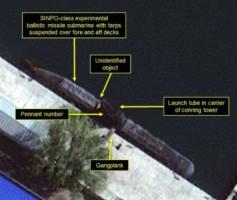 As if things were not complicated enough, it appears that North Korea is building a second and more capable ballistic missile submarine. In addition to developing inter-continental range ballistic missiles launched from land, North Korea has for several years been working on the ability to launch missiles from submarines. The new ballistic submarine may be capable of launching long to intermediate range nuclear-armed missiles.
As if things were not complicated enough, it appears that North Korea is building a second and more capable ballistic missile submarine. In addition to developing inter-continental range ballistic missiles launched from land, North Korea has for several years been working on the ability to launch missiles from submarines. The new ballistic submarine may be capable of launching long to intermediate range nuclear-armed missiles.
There have been reports that the North Koreans have been developing Submarine Launched Ballistic Missiles (SLBM) since at least 2014. In 2016, the North Koreans launched what is believed to be a KN-11 intermediate range ballistic missile into the Sea of Japan from a Sinpo B class submarine, also called Gorae (“whale”).
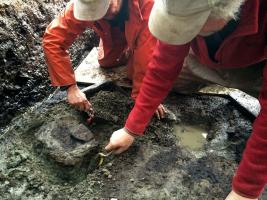
Photo : Grant Callegari/Hakai Institute
The remarkable discovery of 29 ancient footprints just above what would have been the tide line on Calvert Island in British Columbia provides new evidence to support the idea that early humans first migrated to America by sea along what is termed the termed the “kelp highway.” The discovery also confirms the stories told by the Heiltsuk and Wuikinuxv peoples of British Columbia of when their ancestors fished and foraged along a thin green strip of coastline between open ocean and impenetrable inland ice.
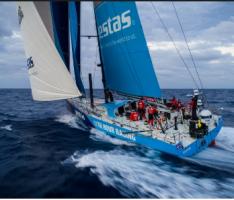 The Southern Ocean has been battering the rigs of the boats sailing in the Volvo Ocean Race (VOR) as the fleet rounds Cape Horn. On Friday, Vestas 11th Hour Racing was dismasted. The Vestas boat lost its mast in 25 to 30 knot northerly winds with 3-meter waves. No one was reported to be injured. The crew cut away the mast to avoid damaging the hull. The dismasting took place southwest of the Falklands Islands. Vestas 11th Hour is now motoring to the Falklands.
The Southern Ocean has been battering the rigs of the boats sailing in the Volvo Ocean Race (VOR) as the fleet rounds Cape Horn. On Friday, Vestas 11th Hour Racing was dismasted. The Vestas boat lost its mast in 25 to 30 knot northerly winds with 3-meter waves. No one was reported to be injured. The crew cut away the mast to avoid damaging the hull. The dismasting took place southwest of the Falklands Islands. Vestas 11th Hour is now motoring to the Falklands.
This is the second major casualty for Vestas 11th Hour, a joint American-Danish team. Near the end of Leg 4 in late January, the boat collided with a fishing boat off Hong Kong, killing one fisherman, sinking the fishing boat and damaging the yacht. The Vestas 11th Hour Racing boat was shipped to New Zealand to repair a large hole in its port bow, forcing it to miss two legs.
The day before Vestas 11th Hour lost its rig, the MAPFRE team temporarily suspending racing for 13 hours to repair the mainsail track, which had separated from the mast, and to repair a ripped mainsail. MAPFRE, which had been the fleet leader, rejoined the race on Friday in sixth place.
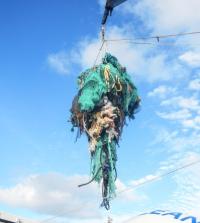
Ghost nets — Photo: The Ocean Cleanup
A new study published in Nature suggests that the Great Pacific Garbage Patch is growing “exponentially” and now spans roughly 617,763 square miles (1.6 million square km), or about three times the size of France. The garbage patch is an accumulation of plastic and floating debris brought together by a gyre, a circular current, in the Pacific between California and Hawaii. It is thought to be the largest ocean garbage patch on earth. According to the new study, the trash is made up of 1.8 trillion pieces of plastic weighing nearly 90,000 tons. This new estimate is between four and sixteen times greater than had previously been predicted.
One aspect of the study that appears to have drawn less attention than the size and the extent of the patch is what it is made of. The study determined that at least 46% of the floating debris are fishing nets and related cordage. These “ghost nets” are a major threat to fish populations around the world and pose an entirely different set of challenges in any potential cleanup.
 Team Sun Hung Kai/Scallywag has put out a timeline of events in the recent loss of John Fisher overboard while sailing in high winds and seas in the Southern Ocean in the Volvo Ocean Race.
Team Sun Hung Kai/Scallywag has put out a timeline of events in the recent loss of John Fisher overboard while sailing in high winds and seas in the Southern Ocean in the Volvo Ocean Race.
- They were sailing in Leg 7 of the Volvo Ocean Race from Auckland, New Zealand to Itajai, Brazil, approximately 1,400 nautical miles west of Cape Horn. The wind was blowing 35-45 knots with 4 to 5 meter seas. Intermittent showers reduced visibility.
- At 15 minutes before sunrise, Fisher unclipped his tether to go forward to “tidy up” a jib sheet. The Team statement says that untethering was “standard procedure when moving between positions.”
- As Fisher moved forward SHK/Scallywag surfed down a large wave and accidentally crash gybed. Fisher was hit by the mainsheet tackle and was knocked overboard. The crew on board believe Fisher was unconscious from the blow before he hit the water. He was wearing a survival suit with a wetsuit hood and gloves and a lifejacket.
- The JON buoy and the horseshoe buoy were thrown off the back of the boat to mark the position
- It took approximately 40 minutes to get the boat under control and to motor sail back to the position where Fisher went overboard. They searched for several hours but found no sign of Fisher or either buoy. In deteriorating weather, they reluctantly abandoned the search.
There seem to several takeaways from the tragedy. Continue reading
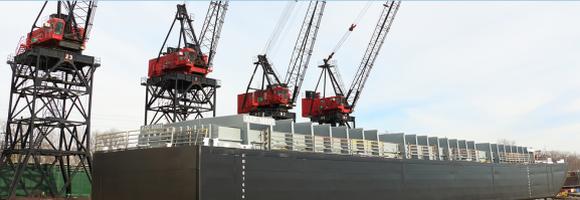 Shipbuilding is a capital intensive and highly competitive business. Remarkably, Jeffboat of Jeffersonville, Indiana, lasted for 184 years. Now, the longest continually operated inland shipyard in the U.S., is reported to be shutting down. Founded in 1834 on the banks of the Ohio River by steamboat builder James Howard, the yard built 3,000 ships in its first 107 years.
Shipbuilding is a capital intensive and highly competitive business. Remarkably, Jeffboat of Jeffersonville, Indiana, lasted for 184 years. Now, the longest continually operated inland shipyard in the U.S., is reported to be shutting down. Founded in 1834 on the banks of the Ohio River by steamboat builder James Howard, the yard built 3,000 ships in its first 107 years.
In 1938, American Barge Line (ABL) purchased the vacant Sweeny Shipyard adjacent to the Howard Shipyard and named it the Jeffersonville Boat and Machine Company, which would come to be known as Jeffboat. In 1942, the US Navy bought both shipyards and used the facility to build 123 Landing Ship-Tanks (LSTs), 23 submarine chasers, and numerous other craft.
In recent years, Jeffboat has been primarily a builder of towboats and barges. Following a drop in orders and a series of layoffs, the management recently told the shipyard union that yard operations would shut down by the end of May.

John Fisher
British sailor, John Fisher, crew on the Volvo Ocean 65 Team Sun Hung Kai / Scallywag, went overboard on Monday and is presumed lost. Fisher went missing while on watch approximately 1,400 miles west of Cape Horn, in high seas, with winds at 35 knots. The water temperature was 9-degrees Celsius (48.2 degrees Fahrenheit.) After searching for Fisher for roughly ten hours, the team reluctantly called off their search and headed for South America.
Richard Brisius, the President of the Volvo Ocean Race, issued the following statement: Continue reading
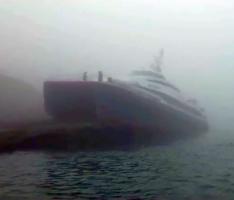 On Sunday, the Pink Dolphin, a 223-ton high-speed ferry loaded with 158 passengers and five crew, ran up on rocks while operating in fog, near the port of Mokpo on the southwest coast of Korea, 400 km south of Seoul. The captain reported that he was maneuvering to avoid a fishing boat when the ferry hit the rocks. The 163 aboard were rescued by the South Korean Coast Guard. Six minor injuries were reported.
On Sunday, the Pink Dolphin, a 223-ton high-speed ferry loaded with 158 passengers and five crew, ran up on rocks while operating in fog, near the port of Mokpo on the southwest coast of Korea, 400 km south of Seoul. The captain reported that he was maneuvering to avoid a fishing boat when the ferry hit the rocks. The 163 aboard were rescued by the South Korean Coast Guard. Six minor injuries were reported.
The grounding took place not far from where the passenger ferry Sewol sank in April of 2014 with the loss of over 300, many of whom were high school students on a field trip. Continue reading
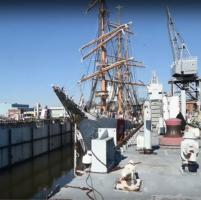 Here is a time-lapse video of the U.S. Coast Guard’s 81-year-old Barque Eagle departing the floating drydock, the ex-USS Oak Ridge, on February 27, 2018, at the Coast Guard Yard, Baltimore, Maryland.
Here is a time-lapse video of the U.S. Coast Guard’s 81-year-old Barque Eagle departing the floating drydock, the ex-USS Oak Ridge, on February 27, 2018, at the Coast Guard Yard, Baltimore, Maryland.
The 295-foot Eagle went on dock in August of 2017, to complete the fourth and final phase of a service life extension project under the Coast Guard’s in-service vessel sustainment program. While in the drydock repairs to the mechanical and electrical systems were completed, was well inspections and structural repairs. The work should provide an additional decade of service life for the historic training vessel, and will allow America’s Tall Ship Eagle to train the Coast Guard’s future officers for years to come. Eagle will now return to the Coast Guard Academy for its summer ports of call.
USCGC Eagle (WIX-327), was built in 1936 as a German sail training ship originally named Horst Wessel. Following World War II, it was taken by the U.S. as war reparations. Eagle serves as a training cutter for future officers of the United States Coast Guard. She is the only active commissioned sailing vessel in U.S. military service.
 More than 150 short-finned pilot whales were found stranded early Friday in Hamelin Bay, Western Australia. Despite the best effort of more than 100 volunteer rescuers, only 6 survived to be returned to the sea. Hamelin Bay is located about 192 miles southwest of Perth.
More than 150 short-finned pilot whales were found stranded early Friday in Hamelin Bay, Western Australia. Despite the best effort of more than 100 volunteer rescuers, only 6 survived to be returned to the sea. Hamelin Bay is located about 192 miles southwest of Perth.
The cause of whale beachings is not known. Worldwide, every year, up to 2,000 cetaceans beach themselves. In February of last year, over 400 pilot whales became stranded, near Farewell Spit, at the northernmost tip of the South Island of New Zealand.
This is not the first mass stranding in the region. In 1996, about 320 long-finned whales became beached in Western Australia’s largest stranding. On the same day of yesterday’s stranding in 2009 more than 80 pilot whales and dolphins died in a mass stranding at the same location.
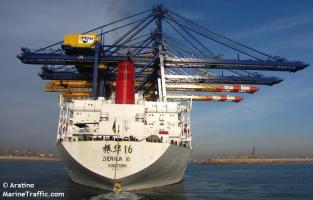 For about 30 minutes early Saturday morning the Delaware Memorial Bridge will close as the heavy lift ship, Zhen Hua 16, with two large container cranes on deck, passes beneath it. The distance from the water level to the top of the cranes is 188 feet, 5 inches which will require the ship to arrive at low tide. Even so, the cranes are expected to clear the bridge with a clearance of only between 4′ and 9′. The cranes on the Zhen Hua 16 are said to be the tallest cargo load ever to pass under the Delaware Memorial Bridge.
For about 30 minutes early Saturday morning the Delaware Memorial Bridge will close as the heavy lift ship, Zhen Hua 16, with two large container cranes on deck, passes beneath it. The distance from the water level to the top of the cranes is 188 feet, 5 inches which will require the ship to arrive at low tide. Even so, the cranes are expected to clear the bridge with a clearance of only between 4′ and 9′. The cranes on the Zhen Hua 16 are said to be the tallest cargo load ever to pass under the Delaware Memorial Bridge.
The cranes are bound for Philadelphia’s Packer Avenue Marine Terminal. They are the first of a next-generation container crane capable of loading and unloading the new generation of post-Panamax ships. The larger container ships will be calling on the US East Coast following the expansion of the Panama Canal. The cranes were manufactured by Shanghai Zhenhua Heavy Industry Co.

Winnie Breegle WAVE Code Talker
On Throw-back Thursday and in honor of Women’s History, here is a slightly reworked post from 2012 about Winnie Breegle, a World War II WAVE (Woman Accepted for Volunteer Emergency Service) and a Navajo code talker, who didn’t happen to be a Navajo.
90-year-old Winnie Breegle spoke at the 2012 Women’s History Month celebration at the Naval Surface Warfare Center in Panama City, FL. She had quite a story to tell. Not only was she a WAVE (Woman Accepted for Volunteer Emergency Service) in World War II but she was also a “code talker,” trained to understand Navajo code as a cryptographer.
In World War II, the code talkers were largely a group of more than 400 Marines who were bilingual Navajo speakers. By using a spoken Navajo code, they were able to dramatically speed up communications while being undecipherable to the Japanese. Most code talkers were Navajo, but as there were too few Navajo speakers, a program was set up to train WAVES to understand the code talkers. Winnie Breegle was one of the WAVES to become a code talker.
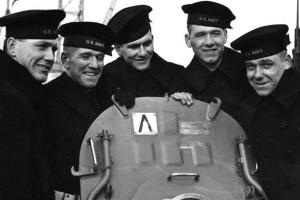 Yesterday we posted about the discovery of the wreckage of the USS Juneau by the Paul Allen’s RV Petrel. The Juneau was sunk by Japanese torpedoes during the Battle of Guadalcanal in November of 1942. Of the 687 men who died when the ship sank, the best remembered are the five Sullivan brothers, George, Frank, Red, Matt, and Al.
Yesterday we posted about the discovery of the wreckage of the USS Juneau by the Paul Allen’s RV Petrel. The Juneau was sunk by Japanese torpedoes during the Battle of Guadalcanal in November of 1942. Of the 687 men who died when the ship sank, the best remembered are the five Sullivan brothers, George, Frank, Red, Matt, and Al.
The five brothers all enlisted together and insisted that they should all serve together. Navy policy had been to separate siblings but exceptions were allowed. George, the oldest brother, said “When we go in, we want to go in together. If the worst comes to the worst, why, we’ll all have gone down together.”
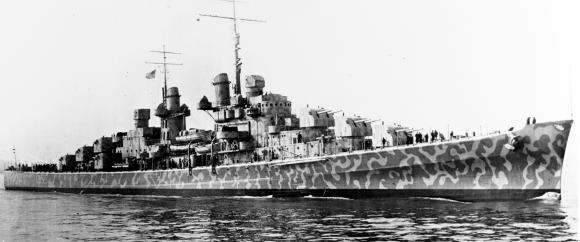 The latest news from Paul Allen’s research vessel Petrel:
The latest news from Paul Allen’s research vessel Petrel:
Wreckage from the USS Juneau (CL-52) was discovered on March 17, 2018, by the expedition crew of Research Vessel (R/V) Petrel. The Juneau was sunk by a Japanese torpedo during the Battle of Guadalcanal, ultimately killing 687 men including all five of the Sullivan brothers. The Atlanta-class light cruiser was found 4,200 meters (about 2.6 miles) below the surface, resting on the floor of the South Pacific off the coast of the Solomon Islands.
“We certainly didn’t plan to find the Juneau on St. Patrick’s Day. The variables of these searches are just too great,” said Robert Kraft, director of subsea operations for Paul Allen. “But finding the USS Juneau on Saint Patrick’s Day is an unexpected coincidence to the Sullivan brothers and all the service members who were lost 76 years ago.” Continue reading
